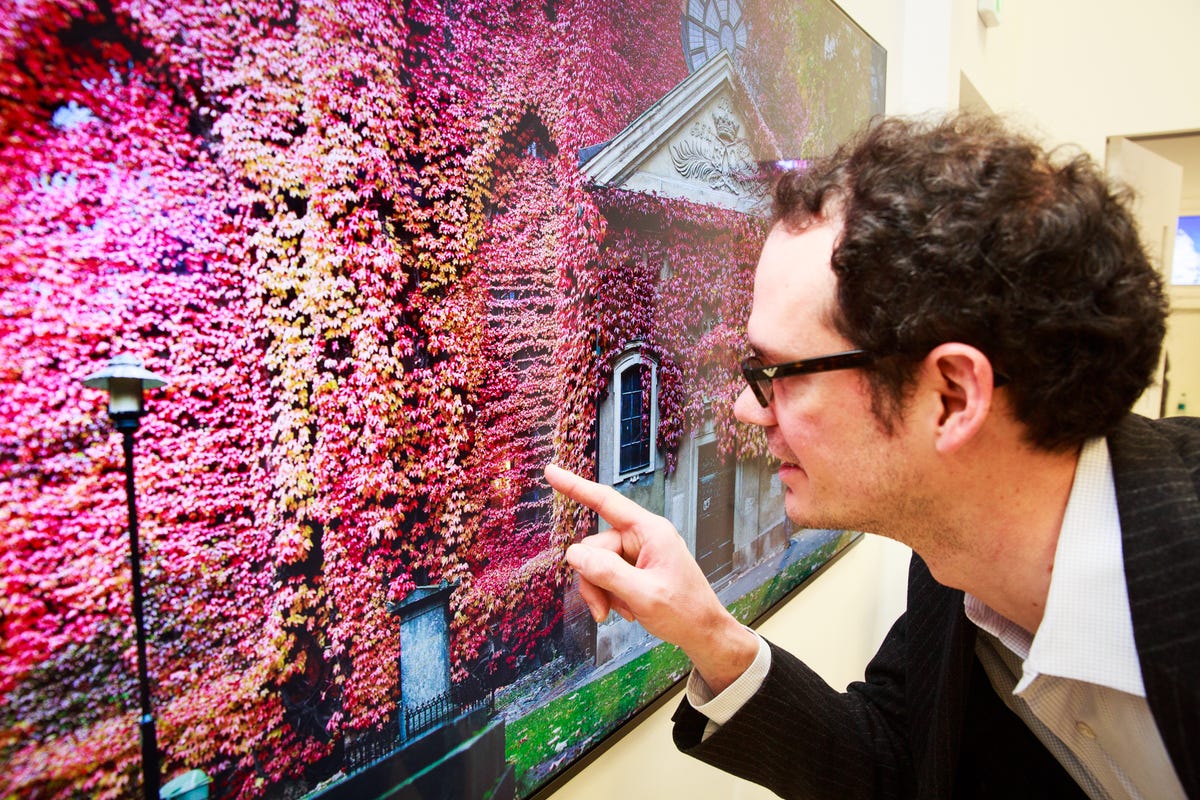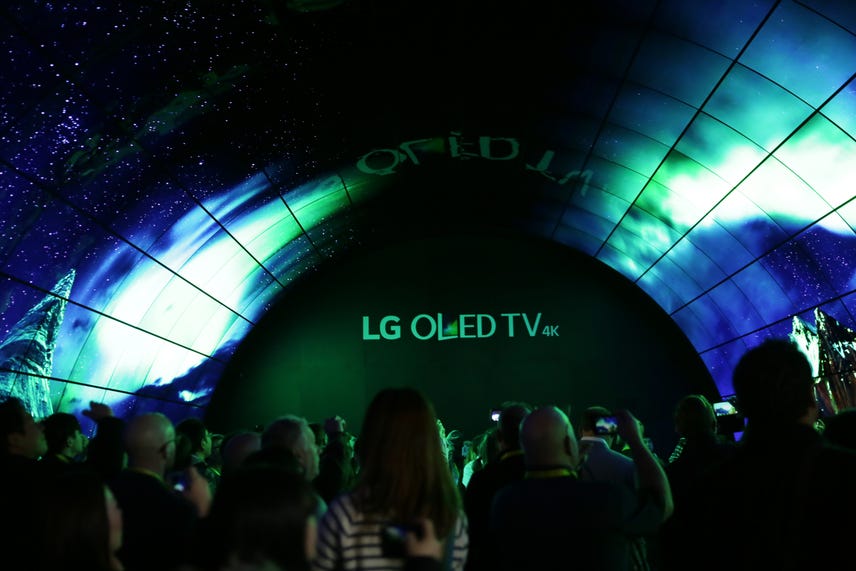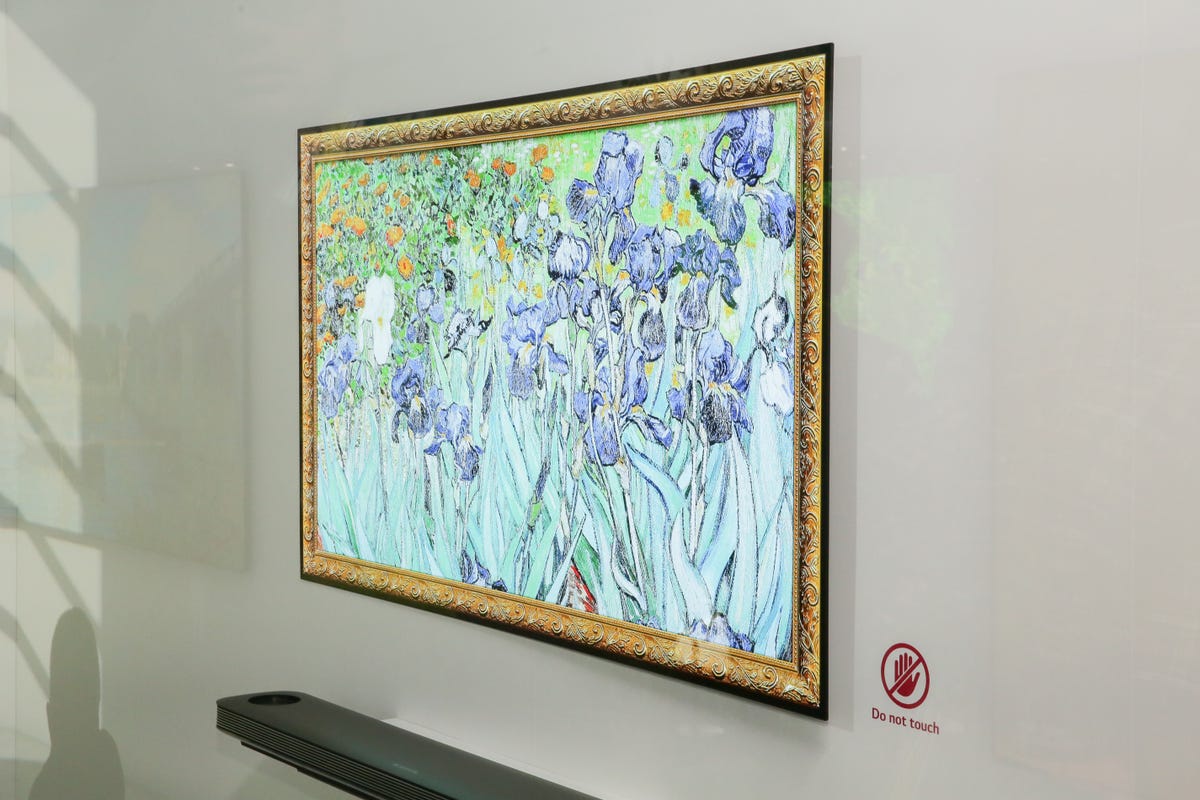 Why You Can Trust CNET
Why You Can Trust CNET TVs of CES 2017
From organic diodes to quantum dots, to 100-inch screens to tunnels lined with curved screens, big TVs are the stars of CES.

2017's next generation of TVs are standing by to dazzle your eyes (and your wallet). Our TV expert David Katzmaier, seen here counting every pixel of a concept 8K TV, introduces the picks of the bunch. Just give him a sec to finish up.

Tunnel of OLED love
OLED (organic light emitting diode) TV technology produces the best picture quality CNET has tested, and LG's booth is the OLED mecca. Its coolest display is a huge tunnel composed of gently curved OLED screens.
LG W7 'wallpaper' OLED TV
Nearly as cool, and actually for sale, is the W7, a TV so thin it's basically wallpaper.

LG W7 'wallpaper' OLED TV
Or wall art.
LG W7 'wallpaper' OLED TV
Seen here against an actual wall (and a key) is what a 3.85 mm thick TV looks like.
LG W7 'wallpaper' OLED TV
Yeah, this 65-inch TV is way thinner than a phone.
LG W7 'wallpaper' OLED TV
LG's booth shows off the wallpaper TV in a cool projection seascape.
LG W7 'wallpaper' OLED TV
...and demonstrates that it's actually semi-flexible.
LG W7 'wallpaper' OLED TV
The W7 screen itself is too thin for actual HDMI ports, so it includes a sound bar into which you plug your gear.
LG W7 'wallpaper' OLED TV
Power and video runs through this thin ribbon cable from the soundbar up to the TV.
LG W7 'wallpaper' OLED TV
The W7 is available in a 65-inch size for $8000, and a 77-inch size shown here. No pricing yet on the 77-inch, but I'm expecting somewhere north of $20,000.
LG E7 OLED TV
If you don't have eight grand for a new TV, you might have to settle for one of LG's other OLED TVs. Here's the E7.
LG E7 OLED TV
It looks very similar to last year's E6, with a sleek-looking speaker bar along the bottom.
LG E7 OLED TV
LG calls the design "picture-on-glass."
LG B7 OLED TV
The company's cheapest 2017 OLED TV will be the B7. No pricing yet, but its predecessor (our favorite TV of 2016) costs $3,000.
LG B7 OLED TV
Even the cheapest OLEDs are extremely slim.
LG B7 OLED TV
Other OLEDs have a thicker chunk to house inputs, the power supply and other stuff.
LG B7 OLED TV
Despite their huge design (and price) disparities, LG says all of its 2017 OLED TVs, from the W7 to the B7, will have the same picture quality. We expect it to be among the best on the market. But one might be better...
Sony A1E OLED TV
Coming later in 2017, Sony's first big-screen OLED, the A1E, will arrive to provide LG with some competition. Here's Sony CEO Kazuo "Kaz" Hirai making the announcement.
Sony A1E OLED TV
Sony spent a lot of time trying to convince me that the A1E's picture will be better than LG's. We'll see.
Sony A1E OLED TV
Sony will sell the A1E in 65- and 77-inch sizes. Pricing has not been announced.
Sony A1E OLED TV
One difference from LG? Sony's A1E has a subwoofer in the angled part of the stand.
Sony A1E OLED TV
And the screen itself acts as a speaker.
OLED TV screen sound
Little transducers behind the screen, seen here at the LG Display booth (LG Display makes the OLED screens for Sony's TV), actually vibrate the screen itself to produce sound.
OLED TV screen sound
I could actually feel it.
OLED TV screen sound
The vibration is strong enough to bounce these plastic balls, but didn't affect the picture as far as I could tell.
Samsung QLED TV
While Sony and LG make OLED TVs, Samsung is sticking to LED-backlit LCD models. It's calling its flagship 2017 TVs QLED.
Samsung QLED TV
Samsung promises its best picture quality TV yet, thanks to new quantum dot technology, which is said to improve brightness and color.
Samsung QLED TV
This year Samsung's best QLED series, the Q9 series shown here, in an 88-inch size suspended from the ceiling, is flat instead of curved.
Samsung QLED TV
QLED sets can be mounted on a stand or flush with the wall using Samsung's new mounting system. The Q8 shown here is a curved model.
Samsung QLED TV
You can also get optional stands.
Samsung QLED TV
This conical one allows the TV to swivel.
Samsung QLED TV
And this one resembles an artist's easel.
LG SJ9500 Super UHD LCD TV
OLED offers top-of-the-range picture quality, but at a price. LG's Super UHD LCD TVs are cheaper, and supposedly LG has improved its image quality compared to the 2016 versions.
LG SJ9500 Super UHD LCD TV
The SJ9500 may not be OLED-thin, but it's still pretty svelte.
Sony X930E LCD TV
The Sony X930E adds support for Dolby Vision so you can watch HDR movies, and Google Home to make your TV part of your smart home setup. It also has a cool patterned backside.
Xiaomi Mi TV 4
Many of the TVs at CES are from lesser-known brands, at least in the US. The Mi TV 4 will only be available in China.
Xiaomi Mi TV 4
It's too cool-looking not to show you anyway.
Xiaomi Mi TV 4
It comes with a sound bar into which you plug your gear.
Xiaomi Mi TV 4
I love the transparent stand legs.
Sony VPL-VZ1000ES
Not every TV at CES is an actual TV. This cabinet-based laser projector is bright enough for any room and costs 25 grand.
Sony VPL-VZ1000ES
Here's where the laser-powered light emerges.
Hisense 100H10D
Those 75-inch TVs probably feel pretty slick -- until they get a load of the 100-inch Hisense 100H10D. It's another projection system, with a surround-sound setup and a short-throw laser projector that beams onto the 100-inch screen. And it costs only $13,ooo.
LG pillar of OLED
And not every TV is for home use. LG Display's OLEDs can be wrapped around pillars for digital signage.
Sony CLEDIS
Another "TV" designed for commercial use, Sony's gigantic crystal LED screen is 32 feet long, 9 feet high (9.75 by 2.75 meters) and impossibly bright. As the largest TV I saw at CES, it seems an appropriate place to end.



